Nexus 4 Includes Support for LTE on Band 4 (AWS)
by Brian Klug on November 23, 2012 5:40 AM ESTI noted in my review of the LG/Google Nexus 4 that the device included hardware necessary for LTE on at least some of its bands, namely bands 1 (2100 MHz), 2 (1900 MHz), and 4 (AWS 1700/2100) based on what I saw in my teardown. Enabling LTE on a given device requires everything in the cellular chain to include support — the cellular baseband to support it must be present and loaded with the appropriate software, the transceiver must be the appropriate kind, and finally the right power amplifiers (PAs) have to be in place for the wider channel bandwidths that LTE brings (up to 20 MHz) over WCDMA (5 MHz).
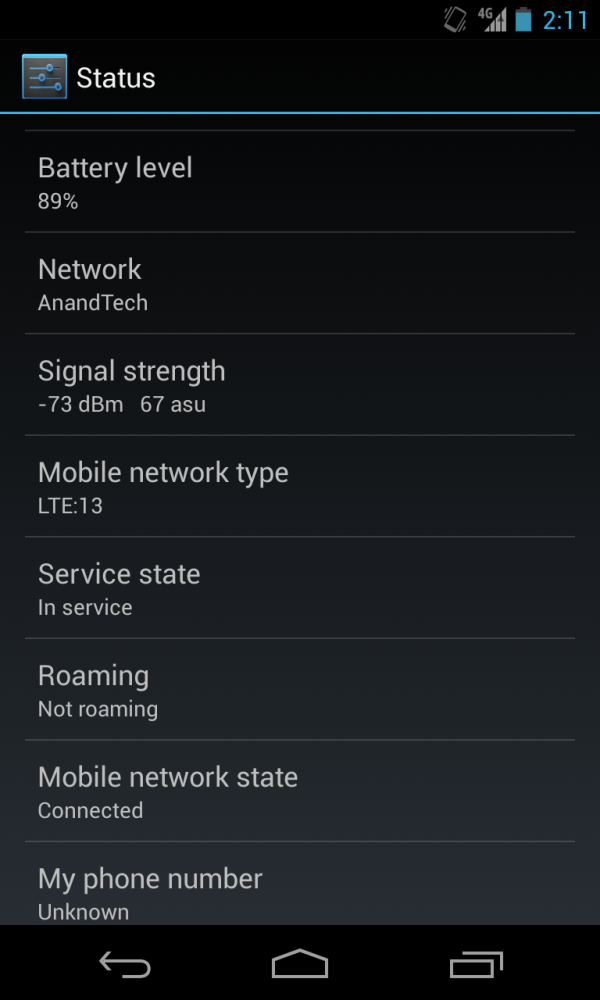
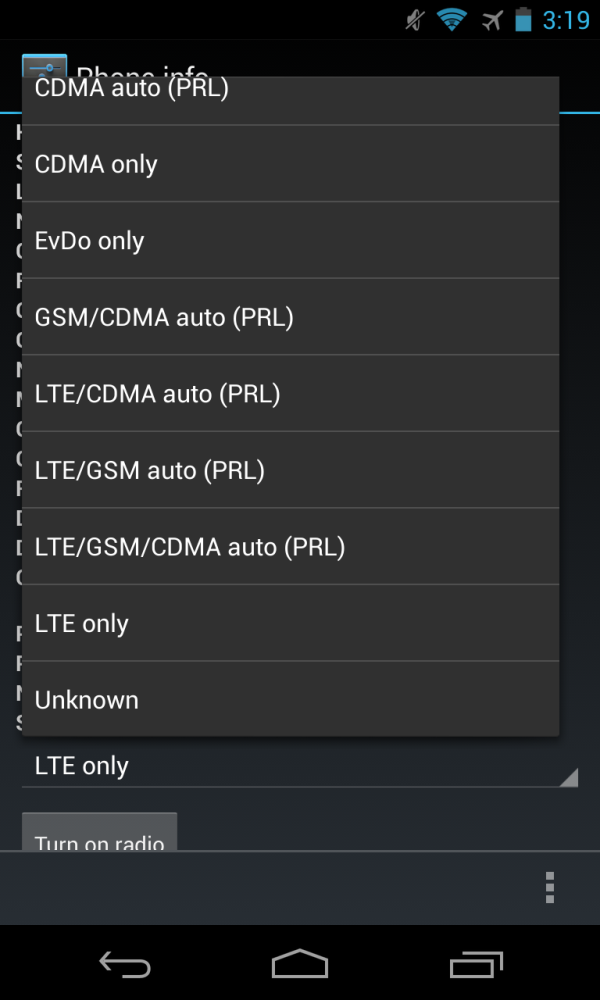
Nexus 4 on Band 4 LTE (Left), Band Preference Setting in *#*#4636#*#* (Right)
In the case of the Nexus 4, the hardware includes the latest and greatest cellular hardware from Qualcomm with MDM9215M, its third generation 28nm Category 3 LTE multimode baseband, and a WTR1605L transceiver. I tore down the Nexus 4 to ascertain whether PAs were present that could work with LTE, and saw indeed that at least bands 4, 2, and 1 did have Avago power amplifiers (A5704, A5702, and ACPM–7251) which noted support for LTE. The remaining piece of the puzzle was software stack, both in Android and inside the version of the AMSS (Advanced Mobile Subscriber Software) running onboard MDM9215M.
Recently some Nexus 4 owners in Canada posted on XDA that they had working LTE support on Band 4 if they enabled the appropriate "Preferred Network Type" in the dropdown menu there. This menu is inside "Phone Info" which has been part of Android forever and can be accessed on almost every Android phone either by dialing *#*#4636#*#* (INFO) or using an app called Phone Info which launches that activity directly.
Recently, Anritsu graciously loaned me an MD8475A signaling tester and LTE/WCDMA/CDMA2000 base station emulator for me to test and evaluate devices with. I tested the Nexus 4 on DC-HSPA+ for the review but didn't think to try testing LTE on the appropriate bands since Google and the FCC documents are both explicit about only WCDMA/GSM being present. I tested for LTE on all the bands that the Nexus 4 includes UMTS support for, starting with 5 MHz wide LTE channels. It appears that Nexus 4 only has support for LTE on Band 4 (AWS) with bandwidths up to 20 MHz in fact. I put together a table for easier parsing. If a band isn't listed, it isn't supported. Update: Lots of people have asked me to test some additional bands (3, 7, 20) because of their international relevance, these unsurprisingly are not supported given the fact that there are no PAs present for them. I've updated the table to be explicit however.
| Nexus 4 LTE Band Coverage | ||||
| E-UTRA (LTE) Band Number | Commonly Known Frequency (MHz) | Bandwidths Supported | ||
| 1 | 2100 | No Support | ||
| 2 | 1900 | No Support | ||
| 3 | 1800 | No Support | ||
| 4 | 1700/2100 | 5, 10, 20 MHz | ||
| 5 | 850 | No Support | ||
| 7 | 2600 | No Support | ||
| 8 | 900 | No Support | ||
| 20 | 800 | No Support | ||
Because testing the 2x2 MIMO configuration requires cabling up the Nexus 4 to the antenna leads directly, and my LG-appropriate antenna connectors haven't arrived yet, I only can test with a 1x1 configuration. The Nexus 4 does include Rx diversity for every band, and thus it's entirely possible on Band 4 that users will see the full 2x2 MIMO rates (37 Mbps on 5 MHz, 73 on 10 MHz, 100 Mbps on 20 MHz), but I can't confirm it directly. For the 1x1 configuration I could test, however, I saw the expected ~75 Mbps on 20 MHz FDD LTE which is very close to the maximum of 75.376 as shown.
The conclusion is that the Nexus 4 at present curiously includes the software profile on MDM9215M that enables support for LTE on Band 4 (AWS), and users only need to set the appropriate network type preference in Android to use it. None of the other bands that there are even power amplifiers for have LTE support, which is unfortunate for users in places where carriers aren't running LTE on AWS, such as the USA. For example, in the USA, AT&T previously discussed plans for LTE on Band 4 but has only rolled out LTE on Band 17 to date, and is rumored to be turning to refarming its PCS (1900 Band 2) and Cellular (850 Band 5) holdings for additional LTE capacity, perhaps in the stead of AWS. T-Mobile US however will use AWS for LTE. Nexus 4 LTE support is definitely unofficial (and somewhat surprising) at this point, but if you're lucky enough to be in a place where your carrier has rolled it out on Band 4, it's just a setting away.
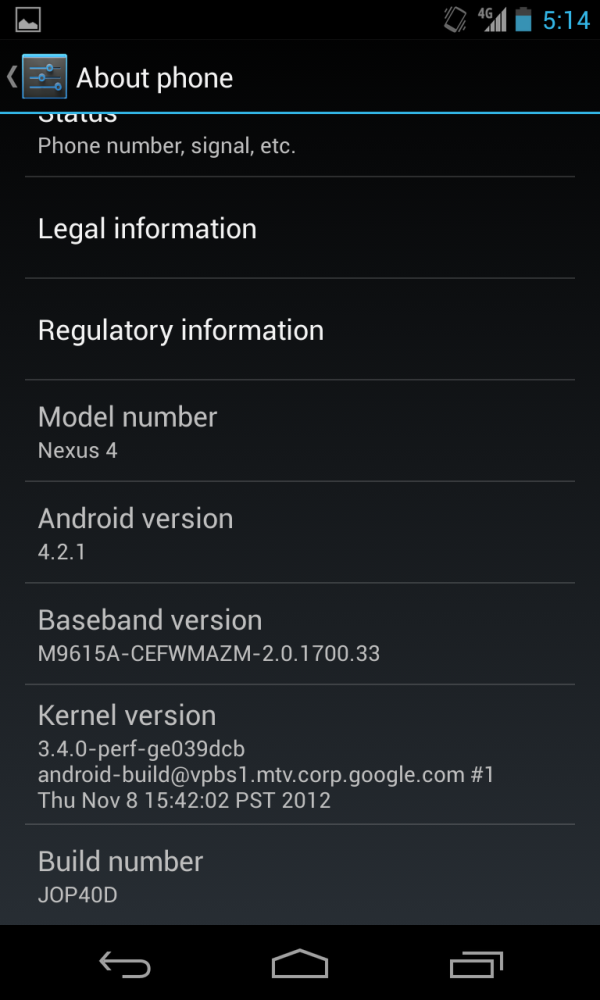
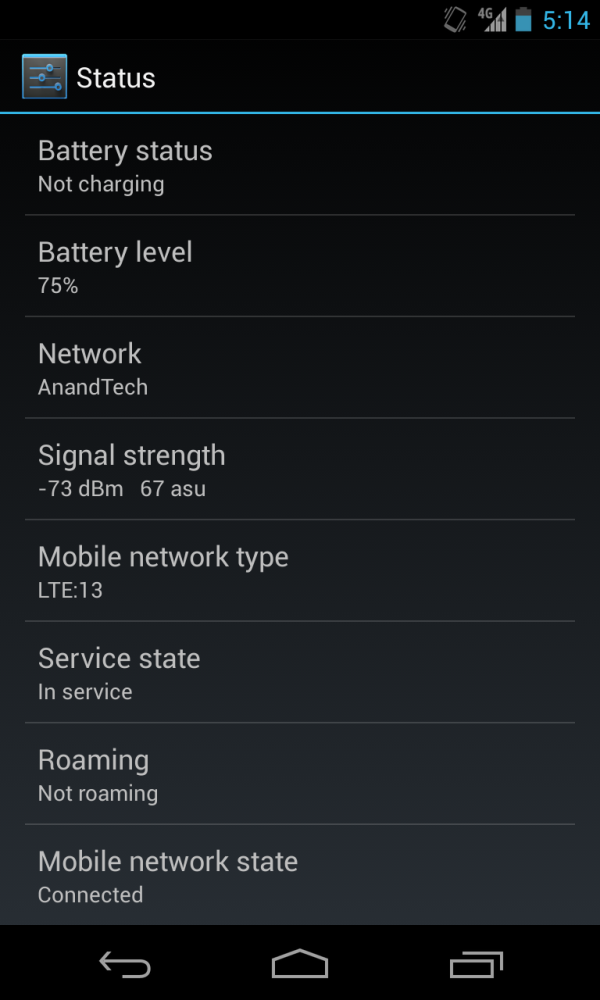
Still working on Android 4.2.1...
Update: This morning an update started rolling out to the Nexus 4, 7, and 10. I suspected initially that Google would quickly disable LTE on band 4 on the Nexus 4 for regulatory reasons (or file a Class II permissive change with the FCC). Interestingly enough the OTA going out to the Nexus 4 bringing it to build JOP40D doesn't disable LTE on band 4 or change the baseband software version at all. I was able to make the device attach the same was as I was previously. This update does fix the missing December option for birthdays in the People application, however.
Source: XDA Developers


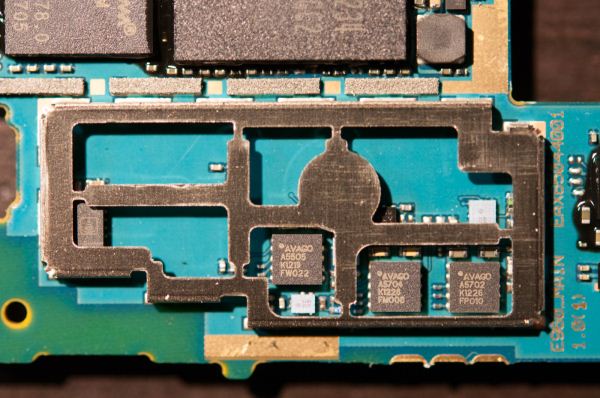














48 Comments
View All Comments
djpavcy - Friday, November 23, 2012 - link
Brian Klug, I have only one thing to say: Your detective work is second to none. Kudos to you sir!tcboy88 - Friday, November 23, 2012 - link
why band 1 (2100mhz) is not supported?while band 4 (1700/2100mhz) is supported?
Even though I do not understand what is the difference between 2100mhz and 1700/2100mhz
But I am in Korea, LG U+ is on band 1, another 2 telco in band 5
Paulman - Friday, November 23, 2012 - link
From what I understand, Band 4 is divided into 1700 MHz and 2100 MHz because one frequency is used exclusively for the upload path and the other is for the download path. So that would be different from Band 1 (2100 MHz, in both directions), I assume?tcboy88 - Friday, November 23, 2012 - link
okay...means I have no luck at all
hopefully there are more magical things to happen
zorxd - Friday, November 23, 2012 - link
band 1 has upload at 1920-1980 MHzhttp://en.wikipedia.org/wiki/UMTS_frequency_bands
Doh! - Friday, November 23, 2012 - link
To be more technically accurate, in addition to band 1, LG U+ also is on band 5. SKT is also on band 3 & 5 while KT is on band 3, 8 & 26. In any event, LTE for Nexus 4 is a no go in Korea. It's a shame 'cause I will be getting a Nexus 4 soon and plan to use it in Korea.bakedpatato - Friday, November 23, 2012 - link
And in addition, the Optimus G is LG's flagship in Korea and the G makes money for LG...the N4 is probably sold at cost or a little more than cost to el goog. Therefore, LG has a vested interest to make as few N4s as possible and to make and sell as many Optimus Gs as possible.aicom - Friday, November 23, 2012 - link
Since this device is not tested for LTE by the FCC, is turning on LTE on the Nexus 4 in violation of the FCC approval?Alexvrb - Sunday, November 25, 2012 - link
Why and how would they get FCC approval for something that doesn't currently exist in the US? There is currently NO LTE network on Band 4, in the US. T-Mobile *PLANS* to start deploying LTE on this band in 2013. But that means two things:1) You still have no LTE right now even if you're using T-Mobile with this phone.
2) You have to use T-Mobile.
So the only way I'd be interested in a Nexus 4 was if I just signed a two year contract with T-Mobile and was unhappy with whatever POS subsidised phone I got suckered into buying. Thankfully that will never happen. The only thing I like about T-Mobile is no overages for data.
It still has a max of 16GB with no SD card. Google's Sergey Brin has gone on the record repeatedly saying that users are too stupid to manage their own PCs, and SD cards in tablets and phones would just confuse you dum-dums. Thanks Sergey! I'll be removing all secondary storage in my devices and relying only on your Cloud post-haste! Not.
senecarr - Monday, November 26, 2012 - link
Actually, MetroPCS uses AWS LTE in about 14 markets (perhaps more, as I think that is an old story I read it in).You would, however, be out of luck trying to take the Nexus 4 to them as their voice network is CDMA.